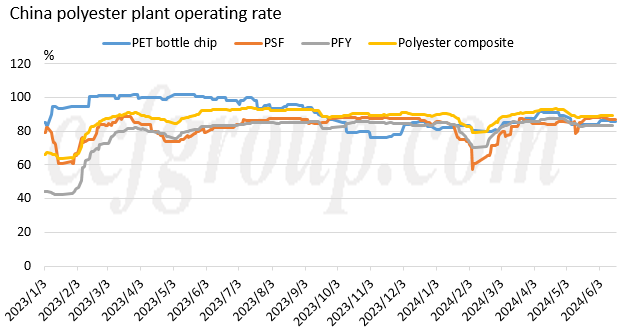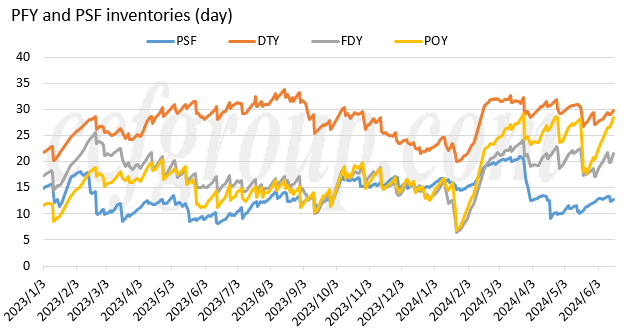Polyester keeps high operating rate in June, but uncertainty in July
In May, due to various unexpected factors, polyester plant operating rate quickly fell below 90%, but then it gradually stabilized in the second half of the month and hovered around 89%.
In June, the polyester plant operating rate still remained firm at above 89% as of the week ending Jun 14. And it is likely to stay high in the range of 89-90%, as one large plant in Xiaoshan may soon restart, and PET bottle chip plant postpones in the maintenance, even if some plant may reduce production moderately.

Judging from the current situation, both polyester plant operating rate and downstream operating rate are relatively firm.
From the perspective of PFY, since large plants adjusting the strategy from cutting production to hiking prices in mid-May, the schedule of production reduction has been postponed. However, at present, with the gradual rebound of PFY inventory, the second half of Jun may see the game between PFY plants and downstream users. It cannot be ruled out that the affordability toward high-priced PFY could force PFY plants to gradually reduce the production, but for now, it may not come until July.
In terms of PSF, although the inventory is also picking up, it is still much lower than the previous high level. Recently, except for the influence from some plant troubles, PSF plant operating rate is quiet stable, while fluctuations are seen in hollow and low-melting products.
As for PET bottle chip, with the restart of the Chengold's plant, the operating rate has increased. And Yisheng Dalian's new plant has also brought about supply increase. For PET bottle chip, the social inventory is already not low, but demand has not improved significantly for the time being, and exports are still affected by the problem of shipping by sea, resulting in the problem of inventory backlogs. Therefore, there are some actions to reduce production, and if the inventory is maintained high or even further increases, therefore could be the possibility of larger production cuts. But the current production cut plan is not too intensive and the time could be delayed.
In addition, besides from the considerations of supply and demand, some plants have indicated that they may arrange overhauls in the summer, but the scale of this kind of maintenance is not large for the time being.

With regard to the downstream sector, it is difficult to simply say whether it is good or bad.
Downstream spinning and weaving operating rate is edging down, but the seasonal drop is not large and there was no significant reduction in production during the Dragon Boat Festival holidays. To some extent, this also brings some support to polyester plants and even raw material plants.
However, in terms of the current situation, the downstream users are indeed reluctant to purchase after the price increase of PFY, because it is difficult for downstream products such as fabric to keep up with the price hike of PFY, due to the slack season, which will be a risk to downstream plants. Especially in the last two years. It has always been difficult for end-users to raise prices, not to mention the off-season.
At present, with the suspension of procurement for a period of time, some downstream texturing and weaving plants have been exhausted the feedstock, promoting a moderate recovery in the sales of polyester recently. But the improvement is limited, as it is based on only maintaining the operation of the equipment. Therefore, in the second half of Jun, the market may pay more attention to the relevant strategies of large plants, as well as the possible reaction of downstream plants.
If there comes a round of sales improvement in the latter half of Jun, perhaps the inventory of PFY could get controlled with no need to reduce production again. But it is also possible that the downstream users may not accept the current price and continue to wait, then the seesaw battle may continue, thus forcing PFY producers to cut production.
In July, the operating rate may be relatively variable, under possible influences such as weaker demand in slack season, production cuts due to losses, power rationing policy as well as routine maintenance.
This year's power rationing policy should not be as harsh as in previous years, but if it occurs during the off-season, the impact may get enlarged, as the operating rate and production growth is high currently. There may be moderate cut of operating rates.
As for PFY market, if downstream users can not accept current PFY prices, it may also cause large manufacturers to adopt appropriate production reduction. It may come in Jul, considering the inventory rebound as well as supply and demand change.
The situation of PSF may be slightly better, but in terms of trend, the seasonal weakening of yarn mills or other end-use demand is expected, and the possibility of moderate production reduction in July cannot be ruled out.
For bottle chips, whether based on low processing spread or high inventories, the need for further production cuts in July may also be relatively strong.
- Top keywords
- Cotton Price
- Cotton Futures Price
- Cotton Futures
- CZCE
- PTA Futures Price
- Chemical Fiber
- Polyester Prices
- Wool price
- PTA Futures
- Shengze Silk
- China
- Yarn Price
- price
- China Textile City
- Fibre Price
- Benzene Price
- Cotton
- Index
- Cotton Index
- PTA
- fabric price
- NYMEX
- Top 10
- textile industry
- Spot Cotton
- Cotton Yarn
- Polyester Price
- Futures
- PTA Price
- cotton yarn price

